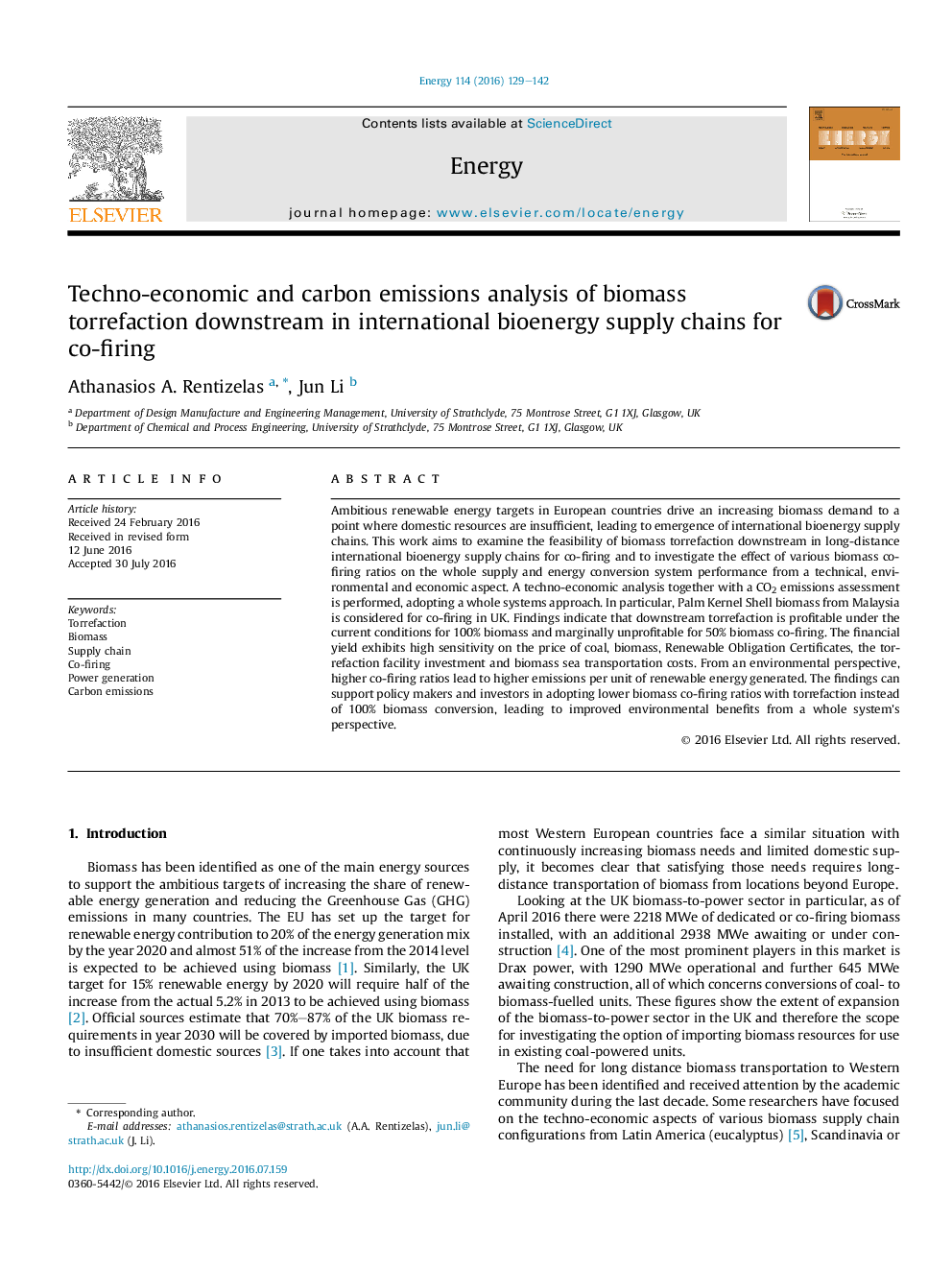| کد مقاله | کد نشریه | سال انتشار | مقاله انگلیسی | نسخه تمام متن |
|---|---|---|---|---|
| 8072834 | 1521434 | 2016 | 14 صفحه PDF | دانلود رایگان |
عنوان انگلیسی مقاله ISI
Techno-economic and carbon emissions analysis of biomass torrefaction downstream in international bioenergy supply chains for co-firing
ترجمه فارسی عنوان
تجزیه و تحلیل فن آوری اقتصادی و کربن انتشار زیست توده در زلزله زدایی در زنجیره تامین زیست انرژی بین المللی برای همکاری شلیک
دانلود مقاله + سفارش ترجمه
دانلود مقاله ISI انگلیسی
رایگان برای ایرانیان
کلمات کلیدی
تورفتگی، زیست توده، زنجیره تامین، آتش سوزی، تولید برق، انتشار کربن،
ترجمه چکیده
اهداف هدفمند انرژی تجدید پذیر در کشورهای اروپایی، تقاضای زیست توده ای را افزایش می دهند تا نقطه ای که منابع داخلی کافی نیستند، منجر به ظهور زنجیره های تامین انرژی بین المللی بین المللی شود. این کار با هدف بررسی امکان تحرک زیست توده پس از زلزله در زنجیره تامین زیست انرژی بین المللی در فواصل زمانی طولانی برای شلیک همزمان و بررسی اثر نسبت های مختلف شلیک زیست توده در کل عملکرد سیستم های عرضه و انرژی از یک سیستم فنی، محیط زیست و جنبه اقتصادی تجزیه و تحلیل تکنولوژیکی و اقتصادی همراه با ارزیابی انتشار گاز دی اکسید کربن انجام می شود و یک رویکرد کلی سیستم را اتخاذ می کند. به طور خاص، توده زیست توده خالص هسته شل از مالزی برای شلیک مشترک در انگلیس مورد توجه قرار گرفته است. یافته ها نشان می دهد که فرسایش پساب در شرایط فعلی برای 100 درصد زیست توده سودمند است و برای تولید 50 درصد زباله های زیست توده سودمند است. عملکرد مالی حساسیت بالایی نسبت به قیمت زغال سنگ، زیست توده، گواهینامه های مجدد مجوز، سرمایه گذاری تسلیحاتی و هزینه حمل و نقل دریایی زیست توده را نشان می دهد. از دیدگاه زیست محیطی، نسبت بالای شلیک بیشتر منجر به انتشار بیشتر در هر واحد تولید انرژی تجدیدپذیر می شود. این یافته ها می تواند سیاست گذاران و سرمایه گذاران را در پذیرش نسبت های کمتری نسبت به سوخت زیستی با رعایت رفاه، به جای تبدیل 100 درصد زیست توده، منجر به بهبود مزایای زیست محیطی از یک منظر کل سیستم شود.
موضوعات مرتبط
مهندسی و علوم پایه
مهندسی انرژی
انرژی (عمومی)
چکیده انگلیسی
Ambitious renewable energy targets in European countries drive an increasing biomass demand to a point where domestic resources are insufficient, leading to emergence of international bioenergy supply chains. This work aims to examine the feasibility of biomass torrefaction downstream in long-distance international bioenergy supply chains for co-firing and to investigate the effect of various biomass co-firing ratios on the whole supply and energy conversion system performance from a technical, environmental and economic aspect. A techno-economic analysis together with a CO2 emissions assessment is performed, adopting a whole systems approach. In particular, Palm Kernel Shell biomass from Malaysia is considered for co-firing in UK. Findings indicate that downstream torrefaction is profitable under the current conditions for 100% biomass and marginally unprofitable for 50% biomass co-firing. The financial yield exhibits high sensitivity on the price of coal, biomass, Renewable Obligation Certificates, the torrefaction facility investment and biomass sea transportation costs. From an environmental perspective, higher co-firing ratios lead to higher emissions per unit of renewable energy generated. The findings can support policy makers and investors in adopting lower biomass co-firing ratios with torrefaction instead of 100% biomass conversion, leading to improved environmental benefits from a whole system's perspective.
ناشر
Database: Elsevier - ScienceDirect (ساینس دایرکت)
Journal: Energy - Volume 114, 1 November 2016, Pages 129-142
Journal: Energy - Volume 114, 1 November 2016, Pages 129-142
نویسندگان
Athanasios A. Rentizelas, Jun Li,
